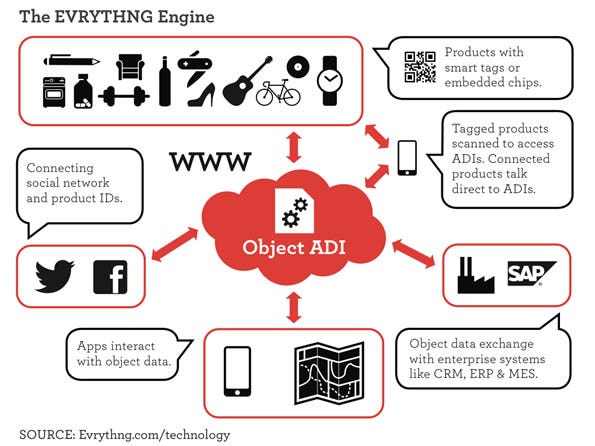At London Startup, Internet Of Things Meets Whiskey BottlesAt London Startup, Internet Of Things Meets Whiskey Bottles
Evrythng offers open standard and engine that will help manufacturers label objects so that they can communicate with people and other objects.

10 Social Networks For Special Interests(click image for larger view and for slideshow)
By now, you've probably have heard about the Internet Of Things, also known as IoT, a moniker the Internet earned when more objects than people became connected to the Web. A decade ago, there were 6.3 billion people living on the planet, and 500 million devices connected to the Internet, but by 2010, while global population was pushing 6.8 billion, the explosion of smartphones had boosted the number of Internet-connected devices to 12.5 billion.
Embedded processors helped us get to this point. In the late 1990s, the Web was still mostly a large library of linked text and images, but as embedded computers got smaller, cheaper and more powerful, they started appearing in household objects like car keys, alarm clocks and kids' toys -- as well as cars and even lamp posts.
The Internet became connected to more things than people on Tuesday, Aug. 10, 2010, as more machines than people signed up to new accounts with the two largest U.S. mobile network operators, Verizon and AT&T. By 2015, Cisco Systems estimates we will be awash with more than 25 billion Internet-connected devices, which will double to 50 billion by 2020, or 6.58 devices per person. This projected average is gobal; the per-person number will be much higher in developed countries.
[ Columnist Thomas Claburn sounds off on what IoT needs to succeed in The Internet Of Pointless, Perilous Things. ]
Cisco CEO John Chambers predicted that the IoT will enhance business revenues by "$14.4 trillion over the next decade."
The problem for CIOs anxiously watching the trend is that there has been very little practical work going on to commercialize it. That is because of the lack of a common standard, according to Andy Hobsbawm, founder and chief marketing officer of Anglo-Swiss startup Evrything.
"At the moment, the Internet of Things is a fragmented space, with little cohesion between actors," he said in an interview. "On one hand, we see companies building complete Internet-connected consumer electronics (smart TVs, radios, security cameras, heating systems, etc.). On the other hand, many companies sell generic building blocks that enable the IoT, from device manufacturers -- who build CPUs, radio chips, sensors, LCD displays, etc. -- to software providers [[who make]] analytics and control software, mobile applications to remotely control your house, etc.."

Andy Hobsbawm, founder of Evrythng
Andy Hobsbawn, founder of EvrythngWhat the IoT movement needs, said Hobsbawm, is a "single, unique and common standard" to make possible the type of interoperability that would allow buying software from one manufacturer and having it "integrate seamlessly with the software provided by another manufacturer." The lack of a standard has been slowing down the progress of an open IoT as CIOs need to focus more on technical standards and protocols rather than what they can actually do once objects are connected, he said.
That's where Hobsbawm's company comes in. It's building an open standard for "things" to interact seamlessly with each other on the Web. If he and his team can pull it off, that would allow the product manufacturers to focus on the novel types of applications and services they can offer on top of Web-connected products, without worrying how their products get connected in the first place.
Once a standard has been established, companies will need new technologies to "digitally super-charge" existing physical objects, Hobsbawm told Information Week UK. "There's a lot of future gazing talk about how this could work tomorrow. But there are some fantastic examples of the Internet of Things at work today, like improving healthcare delivery by connecting medical machines," he said, adding that the device needed to communicate to all of the connected objects is already in our hands – the smartphone. "Your iPhone or Samsung Galaxy represents a critical bridging technology and interface to make products smart, while we wait for future connected things to find their way from factories to our living rooms."
As the cost of sensors, CPUs, storage and connectivity continues to decrease, implementing new IoT technologies into everyday objects is "inevitable," said Hobsbawm. To move the process along, he and his "Swiss rocket scientists" have built the Evrythng Engine, technology that provides "high scale, industrial technology to create and serve millions of intelligent Web identities for a company's products and other objects," said Hobsbawm. "Think of a Facebook for Things, where individual objects, just like people on social networks, have their own unique digital profiles that enable communications, apps and services."

His vision goes beyond that, perhaps to places that might make conservative CIOs a tad uncomfortable. "Using a smartphone to engage with objects around you means that applications become less about big data -- which has perhaps been the cause of so many headaches for CIOs -- and more about networking lots of 'little data,' said Hobsbawm. "Exchanging small, ad hoc but potentially valuable pieces of information between users at the edges means there won't just be one cloud but millions, all transient and forming spontaneously."
This represents a "staggering large opportunity" for London-based Evrythng, says Hobsbawm. "We're tapping into a fast growing, global market space as manufacturers and brands make products 'smart' by connecting their physical assets to add enhanced digital services -- for direct customer engagement, enhanced product functionality, market differentiation, and smarter data analytics," he said. "Our mission is to make every physical thing in the world addressable and part of the Web." The two-year-old Evrythng already has won $1 million in funding from Atomico and other investors in the first round, with further VC investment being sought this year. And Hobsbawm, son of late radical Marxist historian Eric Hobsbawm, has proved he can spot a trend. He worked on Web technologies in the early 1990s with U.K. firm Online Magic and helped found one of the first digital marketing companies, Agency.com, in New York. His co-founder, Niall Murphy, helped set up British Wi-Fi company The Cloud in 2003.
Hobsbawm claims his firm is engaged already with global brands to help them use the Evrythng Engine to track products in the supply chain, access invaluable interaction analytics and create dynamic marketing and post-sales service experiences for customers. "Imagine if your oven could tell you the cheapest place to get spare parts for it, how to find trusted local service help if it breaks down, or offer you sustainable end-of-life solutions such as posting to a local recycling bulletin board," he said enthusiastically.
For companies, the technology could be used to track the identity, location and status of products, allowing them to filter different types of interactions with, say, the smart tags on a product or packing case, by different user groups and social networks.
An early Evrythng customer is Diageo, the world's largest premium drinks company, which ran a campaign in Latin America where each consumer could attach a personalized film tribute to their father to a bottle of whisky. Both giver and receiver could socially share the digital content and opt in to ongoing CRM programs. As a result of the campaign, Hobsbawm claims, Diageo's ROI metrics were ahead of target.
In a testimonial on the Evrythng site, Diageo global VP for marketing innovation Venky Balakrishnan said, "Evrythng's technology is game-changing. We now have a profound strategic opportunity to transform our physical products into owned digital media, which can communicate personalized information and experiences to consumers, exactly when and where they want it."
Evrythng has garnered analyst praise as well, "This is way beyond product tracking," said William Fellows, principal analyst and VP of research for 451. "It's drawing down on Facebook's engineering model and a category called out as 'product relationship management' as anchor points to support its mission. IoT is the organizing principal for its activities, where social, cloud and mobile identities of everyday objects are connected."
To those who would compare his company's work to radio frequency identification tags, the technology that was supposed to do -- and failed at -- something similar not too long ago, Evrythng is not Son Of RFID, said Hobsbawm. "This is a huge shift from RFID, which doesn't work this way at all," he said. "With RFID the tags have to be read by an external reader. In the bigger world of the Internet of Things, there are a range of connectivity technologies -- active and passive tags, sensors, embed controllers, etc. And these technologies provide a constant feedback loop and allow two-way interaction. [That] means you can not only sense objects but also 'actuate' them -- make the physical objects do something different -- remotely and at any time."
He added, "Plus, now there's the social aspect that is a whole new layer on the Internet of Things. This link between objects and people -- think of cars they text us when they're low on power, or NFC-based travel cards we use to swipe our way around or keys which can rent bikes, and so on -- was not in the original RFID proposition at all."
RFID suffered "the lack of meaningful interoperability with other global network tools like the Web," said Hobsbawm. "But the biggest challenges were probably political rather than technical. Organizations, it turned out, didn't want to share their data because of competitive concerns. And the consumer campaigned against the technology because they felt that it was all about the supply chain and there was nothing in it for them other than loss of privacy.
"In contrast, now we see this massive shift towards what's called the 'consumerization of technology' as consumers lead the way in the adoption of the most remarkable and fascinating technologies - and other parts of the economy follow," he said.
If he's right, and technologies like Evrythng's prevail to connect every physical object and enable it to exchange information with people and other objects, "it's hard to think of a single industry that won't be affected," said Hobsbawm.
Attend Online Marketing Summit San Diego, Feb. 11-13,and transform your brand with three full days of digital marketing inspiration, practical learning and networking opportunities. Hear from top brands including Adobe, Eloqua, Intel, Shutterfly, Sony Electronics and more.
About the Author
You May Also Like






